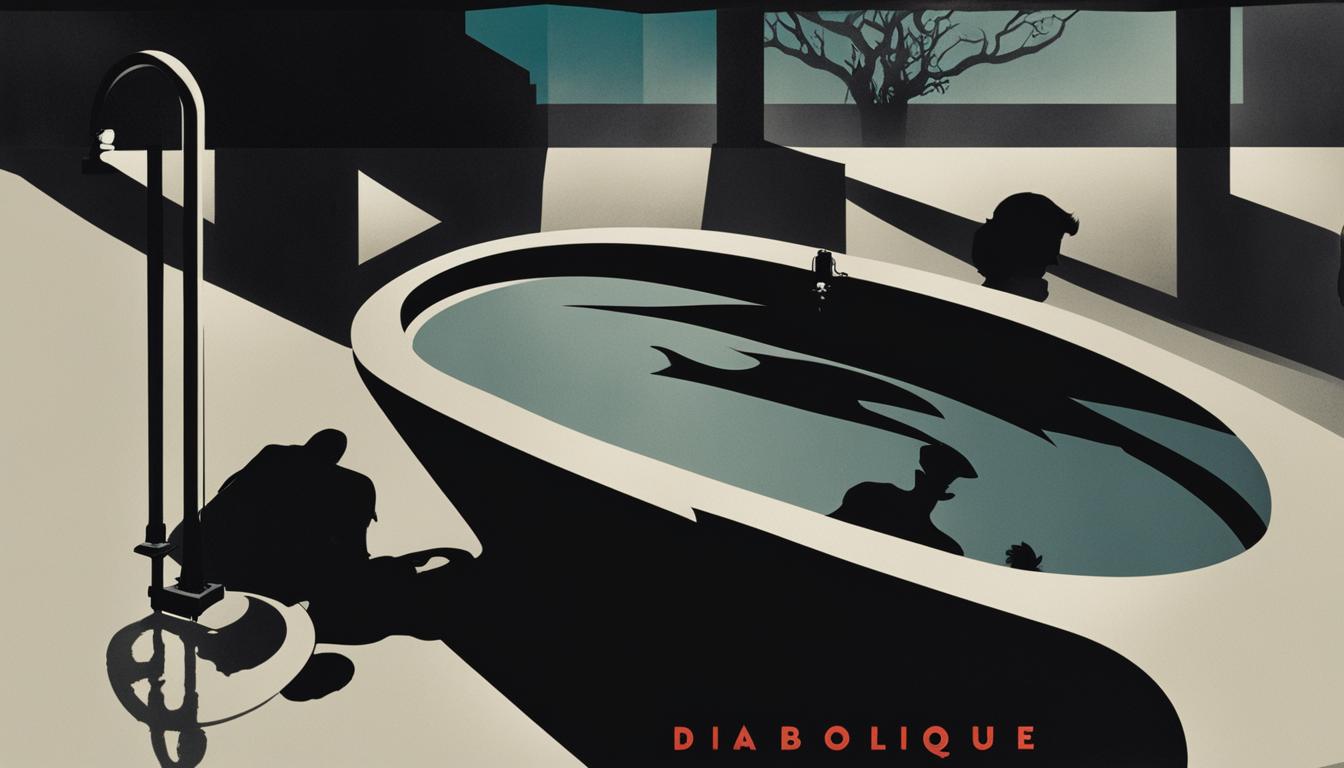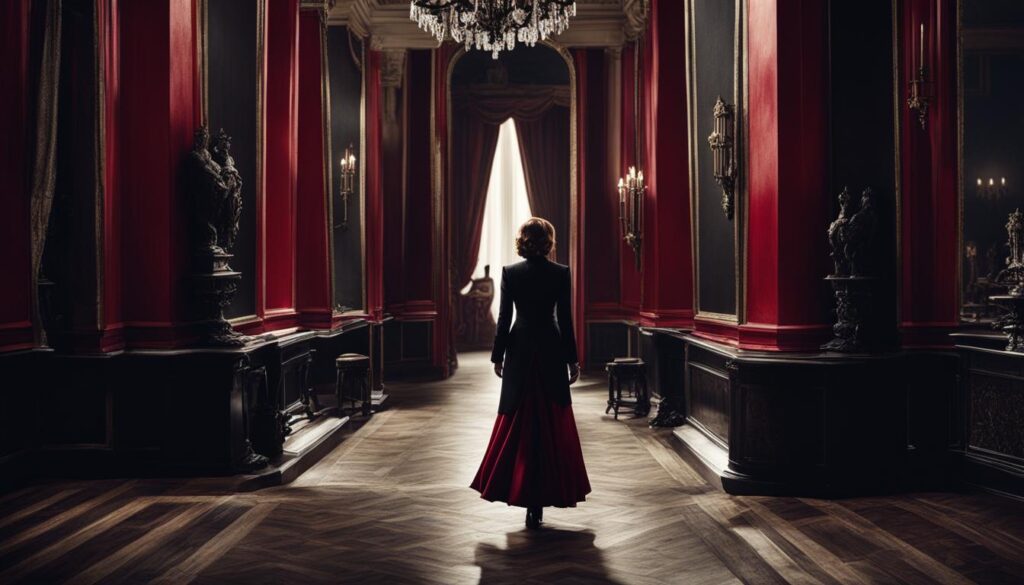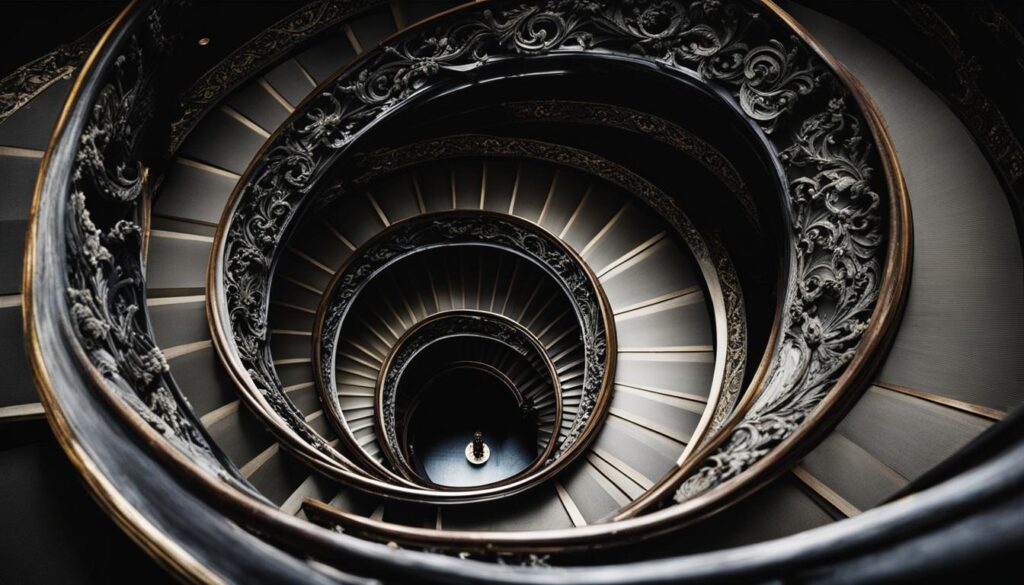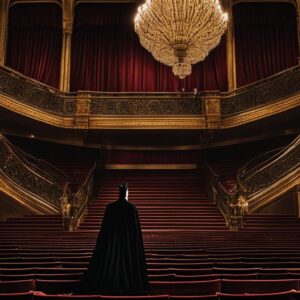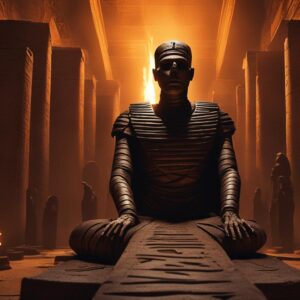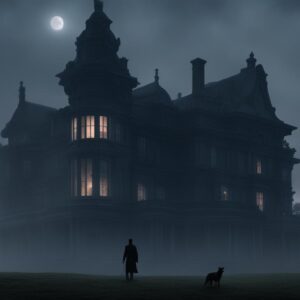Diabolique (1955) is a suspenseful thriller and psychological horror film that has mesmerized audiences for decades. As a classic review, let me take you on a journey through this captivating cinematic masterpiece.
Directed by Henri-Georges Clouzot, Diabolique stars Simone Signoret and Véra Clouzot, delivering powerful performances that intensify the suspense and horror. This French film is known for its dark atmosphere and gripping plot twists, often drawing comparisons to Alfred Hitchcock’s Psycho.
In Diabolique, we are introduced to a carefully crafted storyline filled with mystery, suspense, and psychological twists. The film follows a wife and mistress who conspire to kill an abusive husband, but their plans take an unexpected turn as the body mysteriously disappears. What unfolds is a haunting tale of guilt, paranoia, and supernatural occurrences that will keep you on the edge of your seat until the final moments.
Key Takeaways:
- Diabolique (1955) is a suspenseful thriller and psychological horror film.
- Directed by Henri-Georges Clouzot, the film stars Simone Signoret and Véra Clouzot.
- Diabolique is often compared to Alfred Hitchcock’s Psycho.
- The film’s intricate storyline and gripping plot twists keep audiences captivated.
- Prepare for a haunting tale of guilt, paranoia, and supernatural occurrences.
The Influence of Hitchcock
When it comes to suspenseful scenes and masterful storytelling, Alfred Hitchcock is a name that immediately comes to mind. His films, such as Psycho, have become iconic in the realm of psychological horror. It’s no surprise then that Hitchcock was influenced by other great filmmakers, including Henri-Georges Clouzot, the director of Diabolique (1955).
Diabolique (1955) shares many similarities with Hitchcock’s Psycho, from its dark atmosphere to its unforgettable plot twists. Both films feature a murder taking place in a bathroom, a setting that builds tension and adds to the suspense. Hitchcock even borrowed marketing techniques from Diabolique, urging audiences not to reveal the movie’s secrets, creating a sense of mystery and intrigue.
“Clouzot’s Diabolique (1955) laid the foundation for the psychological thriller genre, influencing filmmakers like Hitchcock in their pursuit of suspenseful and thrilling storytelling.”
While Hitchcock certainly drew inspiration from Diabolique, it’s important to note that Clouzot’s film stands on its own as a thrilling and suspenseful masterpiece. The influence of Hitchcock can be seen in the film, but Diabolique is a testament to Clouzot’s directorial vision and his ability to create suspenseful scenes that captivate audiences.
The Influence of Hitchcock
Henri-Georges Clouzot and His Vision
When discussing the brilliance of Diabolique (1955), it is impossible to overlook the directorial genius of Henri-Georges Clouzot. Clouzot’s unique filmmaking style and storytelling abilities shine through in every frame of the film, creating an immersive and captivating experience for viewers.
Known for his meticulous attention to detail, Clouzot carefully crafts each scene, utilizing precise camera angles, lighting, and composition to enhance the tension and suspense. His restrained approach to filmmaking adds an air of realism to the story, making it all the more chilling and gripping.
Furthermore, Clouzot’s ability to delve deep into the psychology of his characters sets him apart as a master director. He intricately explores the complex motivations and inner workings of each character, allowing viewers to become fully immersed in their struggles and dilemmas. With Diabolique, Clouzot demonstrates his mastery of suspense, leaving audiences on the edge of their seats and craving for more.
Clouzot’s Filmmaking Style
Clouzot’s distinct filmmaking style is characterized by a meticulous attention to detail, a restrained approach to storytelling, and a knack for building suspense. He pays careful attention to every aspect of the filmmaking process, from the set design to the performances of the actors, ensuring that every element works together harmoniously to create a cohesive and impactful story.
In Diabolique, Clouzot’s attention to detail is evident in the atmospheric settings and the subtle visual cues that hint at the hidden secrets within the narrative. The use of light and shadow further heightens the sense of unease, creating a palpable tension that permeates each scene.
Clouzot also excels at building suspense, strategically withholding information and carefully pacing the story to keep audiences guessing. He understands the power of ambiguity and uses it to his advantage, creating moments of uncertainty and surprise that leave a lasting impact on viewers.
The Craft of Storytelling
At the heart of Clouzot’s filmmaking is his commitment to storytelling. He expertly weaves intricate narratives that challenge conventions and provoke thought, capturing the essence of the human condition. With Diabolique, Clouzot explores themes of betrayal, guilt, and revenge, all while keeping audiences enthralled with unexpected plot twists and turns.
Clouzot’s storytelling prowess is complemented by his ability to draw out powerful performances from his actors. He guides them with precise direction, allowing them to fully embody their characters and bring depth and complexity to the screen. In Diabolique, the performances of Simone Signoret and Véra Clouzot are testaments to Clouzot’s skill in eliciting nuanced portrayals that resonate with audiences.
| Clouzot’s Filmmaking Style | The Craft of Storytelling |
|---|---|
| Attention to detail | Intricate narratives |
| Restrained approach to storytelling | Themes of betrayal, guilt, and revenge |
| Building suspense | Unexpected plot twists and turns |
| Powerful performances | Nuanced portrayals |
The Gripping Plot
At the heart of Diabolique (1955) is a gripping plot that revolves around a murder and its chilling aftermath. The story follows a wife and mistress who conspire to kill an abusive husband. However, when the body mysteriously disappears, they find themselves haunted by the man they thought was dead. The film is filled with psychological twists and turns, keeping viewers engaged and guessing until the final moments. Diabolique’s intricate plot is a testament to Clouzot’s storytelling prowess and his ability to create suspenseful and thought-provoking narratives.
| Key Plot Elements | Description |
|---|---|
| Murder Conspiracy | The wife and mistress plot to kill an abusive husband. |
| Disappearing Body | The body of the murdered husband mysteriously disappears, leading to confusion and fear. |
| Psychological Twists | The characters are haunted by the man they believed to be dead, leading to psychological turmoil and uncertainty. |
“The plot of Diabolique is a rollercoaster ride of suspense and unexpected twists. Every moment keeps you on the edge of your seat, eagerly anticipating what will happen next.” – Film Critic
Diabolique’s plot is a masterclass in suspenseful storytelling. The film keeps viewers engaged and invested in its characters, constantly questioning their motives and actions. The psychological twists add an extra layer of complexity, making it a truly gripping and unforgettable experience.
Powerful Performances
One of the standout qualities of Diabolique (1955) is the powerful performances delivered by its lead actresses, Simone Signoret and Véra Clouzot. These two talented women bring their characters to life with a level of depth and nuance that elevates the film to a whole new level. Signoret portrays Nicole, the mistress, with a perfect balance of strength and vulnerability, capturing the audience’s attention with her captivating presence. Clouzot, on the other hand, brings a sense of complexity to the character of Christina, the wife, showcasing her internal struggles and creating a dynamic contrast with Signoret’s Nicole.
The chemistry between Signoret and Clouzot is palpable, creating a believable and compelling dynamic between their characters. As the story unfolds and their secrets unravel, the bond between Nicole and Christina deepens, resulting in a complex and captivating portrayal of their shared experiences. Signoret and Clouzot’s performances complement each other perfectly, adding an extra layer of intensity to the already gripping storyline.
A Classic French Thriller
When it comes to classic movies, Diabolique (1955) is a standout in the thriller genre. This French cinema masterpiece has left an enduring legacy, captivating audiences with its suspenseful plot and masterful storytelling. Directed by Henri-Georges Clouzot, Diabolique is a testament to the enduring power of classic movies and the cinematic legacy they leave behind.
Diabolique’s influence can be seen in subsequent works, both in France and internationally. Its dark and suspenseful atmosphere has inspired filmmakers to create their own thrilling narratives. The film’s intricate plot, filled with unexpected twists and psychological turns, keeps viewers on the edge of their seats and has become a benchmark for the genre.
One of the strengths of Diabolique lies in its ability to deliver powerful performances that resonate with audiences. Simone Signoret and Véra Clouzot bring depth and complexity to their respective characters, showcasing their talent and adding an extra layer of intensity to the story. The chemistry between the two actresses is palpable, highlighting the shared secrets and the bond that develops as they navigate the dangerous world they find themselves in.
In summary, Diabolique is a classic French thriller that continues to captivate audiences with its suspenseful plot, powerful performances, and enduring cinematic legacy. Its influence on the genre and its contribution to French cinema cannot be overstated. Diabolique remains a must-watch for cinephiles and a testament to the timeless power of classic movies.
The Art of Suspense
One of the defining features of Diabolique (1955) is its mastery of suspense. Clouzot expertly builds tension throughout the film, keeping viewers on the edge of their seats. From the initial plot setup to the climactic moments, the film keeps audiences guessing and engrossed in its psychological web. The carefully crafted atmosphere and chilling cinematography contribute to the overall sense of unease and make Diabolique a standout in the genre of psychological horror.
Clouzot’s meticulous attention to detail and precise pacing create a palpable sense of suspense. Every scene is filled with tension, emphasizing the psychological horror that permeates the film. The use of light and shadow, combined with clever camera angles and haunting music, adds to the overall atmosphere of unease. These stylistic choices heighten the audience’s anticipation, making each twist and turn all the more impactful.
“Diabolique keeps you on the edge of your seat, never letting you relax or predict what will happen next. It’s a masterclass in tension-building and psychological thrills.”
The suspense in Diabolique is not just limited to the plot twists, but also extends to the emotions and motivations of the characters. Clouzot masterfully plays with the audience’s expectations, subverting traditional tropes and creating complex, multi-dimensional characters. This adds an extra layer of depth to the film, keeping viewers engaged in the psychological journey of the protagonists.
Overall, the art of suspense is at its finest in Diabolique. Clouzot’s meticulous attention to detail, combined with the haunting atmosphere and captivating performances, make it a standout in the genre of psychological horror. The film continues to thrill and captivate audiences to this day, solidifying its status as a timeless classic.
Clouzot’s Game of Twists
Diabolique (1955) is renowned for its expertly crafted plot twists and a surprise ending that leaves viewers in awe. Henri-Georges Clouzot, the film’s director, masterfully constructs a narrative that is filled with unexpected turns and narrative surprises. From the onset, the story keeps audiences on the edge of their seats, introducing shocking revelations at every corner.
Clouzot’s ability to surprise and subvert expectations is a testament to his storytelling skills. The plot of Diabolique weaves a web of mystery and suspense, constantly keeping viewers guessing and questioning their assumptions. Each twist in the storyline adds a new layer of complexity, building upon the tension and uncertainty that permeates the film.
“Just when you think you’ve figured it all out, Diabolique throws another curveball, leaving you breathless and eager for more.”
The surprise ending of Diabolique is particularly memorable. Without giving away any spoilers, it’s safe to say that Clouzot’s carefully constructed narrative finds its culmination in a shocking and unexpected manner. The conclusion ties all the narrative threads together, revealing the true extent of the characters’ actions and motives.
The plot twists, surprise ending, and narrative surprises in Diabolique are remarkable achievements that have solidified the film’s reputation as a classic in the thriller genre. Clouzot’s meticulous attention to detail and ability to keep viewers guessing make Diabolique a truly memorable and suspenseful cinematic experience.
| Aspect | Details |
|---|---|
| Plot Twists | Multiple unexpected turns that keep viewers engaged. |
| Surprise Ending | A shocking conclusion that leaves audiences in awe. |
| Narrative Surprises | Revelations and twists that subvert expectations throughout the film. |
The Influence on Hitchcock’s Vertigo
When discussing the impact and legacy of Diabolique (1955), it is impossible to overlook the profound influence it had on Alfred Hitchcock’s iconic film, Vertigo. From thematic elements to narrative structure and visual style, Diabolique served as a source of inspiration for Hitchcock and helped shape the direction of his masterpiece.
Both films delve into the realms of psychological suspense and explore the complexities of human relationships. Diabolique’s exploration of deception, manipulation, and the blurred lines between truth and illusion resonated with Hitchcock, who masterfully infused these themes into Vertigo. The dark and atmospheric tones present in both films create an eerie and unsettling ambiance that draws audiences into a world of intrigue and mystery.
Additionally, Diabolique’s use of plot twists and unexpected turns left a lasting impression on Hitchcock. The narrative surprises in Clouzot’s film challenged conventional storytelling and pushed the boundaries of audience expectations. This approach undoubtedly influenced Hitchcock’s own narrative choices in Vertigo, resulting in a film that continues to captivate audiences with its unpredictable twists and turns.
Overall, Diabolique’s impact on Hitchcock’s Vertigo cannot be overstated. The similarities in themes, narrative structure, and visual style demonstrate the lasting legacy of Clouzot’s masterpiece and its profound influence on one of cinema’s greatest directors.
Table: A Comparison of Diabolique and Vertigo
| Aspects | Diabolique (1955) | Vertigo (1958) |
|---|---|---|
| Themes | Deception, manipulation, truth versus illusion | Obsession, identity, reality versus fantasy |
| Narrative Structure | Twists and turns, unexpected revelations | Complex narrative layers, ambiguous storytelling |
| Visual Style | Dark and atmospheric, use of shadows | Dreamlike sequences, vivid color palette |
| Impact | Influenced subsequent psychological thrillers | Became a defining work in Hitchcock’s filmography |
The table above showcases the similarities and influences between Diabolique and Vertigo. While both films possess their own unique qualities, it is clear that Diabolique played a significant role in shaping the themes, narrative choices, and visual aesthetics of Hitchcock’s masterpiece.
The Legacy of Diabolique
Diabolique (1955) has left an enduring impact on the world of cinema, solidifying its status as a cinematic masterpiece. Its innovative storytelling, masterful direction, and captivating performances have made it a timeless classic that continues to be studied, analyzed, and appreciated by filmmakers, critics, and audiences alike.
This French thriller has had a significant influence on subsequent works, both in France and internationally. Its dark and suspenseful atmosphere, intricate plot twists, and unforgettable characters have set a benchmark for the genre, inspiring filmmakers to push the boundaries of storytelling and suspense.
Diabolique’s film legacy can be seen in the works of numerous directors who have been inspired by its expert craftsmanship. From its meticulously planned narrative surprises to its breathtaking visuals and sound design, the film showcases the artistry and vision of director Henri-Georges Clouzot.
The Enduring Impact
Decades after its release, Diabolique continues to captivate audiences with its enduring impact. Its exploration of human nature, moral ambiguity, and the consequences of dark secrets resonate with viewers, making it a film that stands the test of time.
The film’s legacy goes beyond its initial release and critical acclaim. It remains a cornerstone of French cinema, a touchstone for filmmakers seeking to create suspenseful and thought-provoking narratives, and a testament to the power of cinematic storytelling.
| Key Points | Impact |
|---|---|
| Innovative storytelling | Set a benchmark for the genre |
| Masterful direction | Inspired filmmakers to push boundaries |
| Captivating performances | Resonates with audiences long after viewing |
| Meticulously planned narrative surprises | Inspires filmmakers to create suspenseful narratives |
| Breathtaking visuals and sound design | Displays the artistry and vision of Clouzot |
“Diabolique is a masterpiece of suspense that continues to captivate audiences with its expert craftsmanship and thought-provoking narrative. Its enduring impact on the world of cinema is a testament to its status as a true cinematic masterpiece.” – Film Critic
The Craftsmanship Behind Diabolique
When it comes to the filmmaking techniques that make Diabolique (1955) a truly exceptional cinematic experience, it’s hard to know where to begin. From the breathtaking cinematography to the meticulously crafted sound design, every aspect of the film showcases the masterful craftsmanship of director Henri-Georges Clouzot and his team.
The cinematography in Diabolique is both visually stunning and thematically rich. The carefully chosen camera angles and lighting enhance the suspenseful atmosphere of the film, drawing viewers deeper into the intricate storyline. Each shot is meticulously composed, effortlessly capturing the emotions and tension of the characters. Whether it’s the dark and shadowy corridors of the boarding school or the claustrophobic interiors of the characters’ rooms, the cinematography in Diabolique transports the audience into the heart of the narrative.
The sound design of Diabolique is equally impressive, heightening the suspense and adding another layer of intensity to the film. The carefully crafted audio elements, from the haunting score to the subtle background noises, create a sense of unease and keep viewers on the edge of their seats. The use of silence is also masterfully employed, creating moments of tension and emphasizing the psychological twists and turns of the plot.
The Craftsmanship Behind Diabolique
Clouzot’s attention to detail and commitment to excellence can be seen throughout every frame of Diabolique. The film’s craftsmanship is evident in the seamless integration of its various elements, from the cinematography and sound design to the direction and performances. It is a testament to the collaborative efforts of the entire filmmaking team that Diabolique remains a timeless classic, revered for its artistry and ability to captivate audiences.
| Aspect | Details |
|---|---|
| Cinematography | Breathtaking visuals, carefully composed shots, exceptional use of lighting |
| Sound Design | Haunting score, well-crafted audio elements, effective use of silence |
| Attention to Detail | Meticulous direction, seamless integration of elements, commitment to excellence |
Each of these aspects contributes to the overall craftsmanship of Diabolique, elevating it to the status of a true cinematic masterpiece. As viewers, we are fortunate to witness the result of Clouzot’s vision and the dedication of the entire filmmaking team, who poured their talent and expertise into every frame. The craftsmanship behind Diabolique is a testament to the power of cinema to transport, thrill, and leave a lasting impact on audiences.
The Thrills of Diabolique – A Personal Perspective
As an avid fan of suspenseful thrillers, I must admit that Diabolique (1955) holds a special place in my heart. From the moment the film begins, it grabs hold of your attention with its captivating storytelling and masterful direction. Henri-Georges Clouzot’s vision shines through in every frame, creating an atmosphere that is both chilling and mesmerizing.
One of my favorite aspects of Diabolique is its ability to keep you on the edge of your seat. The plot is filled with unexpected twists and turns, constantly challenging your expectations and leaving you guessing until the very end. The psychological twists in the narrative make for a thought-provoking viewing experience, as you delve into the dark and complex minds of the characters.
Throughout the film, I found myself engrossed in the powerful performances of Simone Signoret and Véra Clouzot. Their portrayals of Nicole and Christina, the two women entangled in a web of secrets and deceit, are nothing short of captivating. The chemistry between the two actresses is palpable, and their performances elevate the tension and intensity of the story.
Diabolique is filled with countless unforgettable moments that linger in your mind long after the credits roll. From the suspenseful opening scenes to the shocking conclusion, the film keeps you hooked from start to finish. Clouzot’s craftsmanship is evident in every aspect, from the cinematography that creates a haunting atmosphere to the meticulous sound design that adds to the overall sense of unease. It truly is a cinematic masterpiece that deserves its place among the greatest thrillers of all time.
The Thrills of Diabolique – A Personal Perspective
“From the moment the film begins, it grabs hold of your attention with its captivating storytelling and masterful direction.”
As an avid fan of suspenseful thrillers, I must admit that Diabolique (1955) holds a special place in my heart. From the gripping plot to the powerful performances, this film is a standout in the genre. The captivating storytelling and masterful direction of Henri-Georges Clouzot create a truly unforgettable cinematic experience.
One of the reasons why Diabolique resonates with me is its ability to keep you guessing. The intricate plot is filled with psychological twists and turns that keep you on the edge of your seat. Just when you think you have it all figured out, the film surprises you with unexpected revelations and plot twists. It’s a testament to Clouzot’s storytelling prowess and his ability to create suspenseful narratives.
The performances of Simone Signoret and Véra Clouzot are another highlight of the film. Their dynamic on-screen chemistry and nuanced portrayals of complex characters add depth and intensity to the story. You can’t help but be drawn into their world and feel the emotional weight of their actions.
From start to finish, Diabolique keeps you captivated with its suspenseful atmosphere and unforgettable moments. The craftsmanship behind the film, from the haunting cinematography to the meticulous sound design, elevates it to the status of a true cinematic masterpiece. It’s a thriller that will leave you breathless and thinking long after the final scene fades.
Conclusion
In conclusion, Diabolique (1955) is a classic thriller that truly stands the test of time. From its suspenseful plot to its exceptional filmmaking techniques, this film has earned its place as a cinematic masterpiece.
The combination of psychological horror and gripping storytelling makes Diabolique a must-watch for fans of the genre. Henri-Georges Clouzot’s directorial vision shines through every frame, showcasing his mastery of suspense and creating an unforgettable cinematic experience.
With its powerful performances and dark atmosphere, Diabolique remains a benchmark for classic thrillers. Whether you’re a cinephile or a casual moviegoer, this film is sure to leave you on the edge of your seat and craving for more.
So, if you’re looking for a classic thriller that embodies cinematic mastery, look no further than Diabolique (1955). Watch it and be immersed in a world of suspense, intrigue, and unforgettable storytelling.
FAQ
Is Diabolique (1955) similar to Alfred Hitchcock’s Psycho?
Yes, Diabolique has often been compared to Psycho for its suspenseful scenes and shared elements, such as a murder in a bathroom.
Who directed Diabolique (1955)?
Henri-Georges Clouzot directed the film.
What is the plot of Diabolique (1955)?
The film follows a wife and mistress who conspire to kill an abusive husband, but when the body disappears, they find themselves haunted by the man they thought was dead.
Who are the lead actresses in Diabolique (1955)?
Simone Signoret and Véra Clouzot star in the film.
What is the legacy of Diabolique (1955)?
Diabolique is considered a classic of French cinema and has had a lasting impact on the thriller genre.

